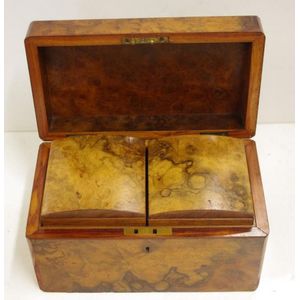Late Georgian Burr Yew Tea Caddy with Twin Canisters
Large late Georgian burr yew tea caddy, on flat bun feet and wheat basket handles, with matching twin canister interior, has mixing bowl and key, 15 cm x 30.5 cm, 15 cm high
You must be a subscriber, and be logged in to view price and dealer details.
Subscribe Now to view actual auction price for this item
When you subscribe, you have the option of setting the currency in which to display prices to $Au, $US, $NZ or Stg.
This item has been sold, and the description, image and price are for reference purposes only.
- Burr - Burr (or in the USA, burl) is the timber from the knotted roots or deformed branch of the tree, which when cut, displays the small circular knots in various gradations of colour. It is always cut into a decorative veneer, most commonly seen as burr walnut on 19th century furniture.
- Georgian - As an English stylistic period, Georgian is usually taken to cover the period from George I (1714) to the Regency of Prince George (1811-20), although the period from 1800 to 1830 is sometimes designated as the Regency period. During the Georgian period the great English cabinetmakers and designers such as Chippendale, Hepplewhite, Adam Sheraton etc., were all active.
Therefore there isn't a single 'Georgian style' as such and to say something is 'Georgian', usually means it was made between 1714 and 1830. This assumes we discount George V and George VI, both being from the 20th century.
The styles popular at the time of each reign were:
George I (1714-1727) saw out the last years of the Baroque period.
George II (1727-1760) reigned during the Rococo period.
George III (1760-1820) saw the last gasp of the Rococo, all of the early Neo-Classic 'Adam style' and most of the later neo-Classic 'Regency style'.
George IV (Prince Regent 1820-1830)encompassed the last of the 'Regency' style.
William IV's reign (1830-1837) was something of a no man's land (stylistically) and he wasn't a 'George' anyway. He covered the last glimmerings of 'Regency' and the start of the 'Victorian' style.
This item has been included into following indexes:
Visually similar items

Good 19th tea caddy, width 25 cm, depth 14 cm x height 15 cm approx
Sold by
in
for
You can display prices in $Au, $US, $NZ or Stg.

A Victorian brass bound walnut writing box, 40 cm wide, 25 cm deep, 18 cm high
Sold by
in
for
You can display prices in $Au, $US, $NZ or Stg.

A decorative Chinese box. Height 18 cm. Width 390 Depth 20.5 cm
Sold by
in
for
You can display prices in $Au, $US, $NZ or Stg.

Regency rosewood sarcophagus tea caddy with brass inlay, 29.5 cm wide, 16 cm high approx
Sold by
in
for
You can display prices in $Au, $US, $NZ or Stg.
